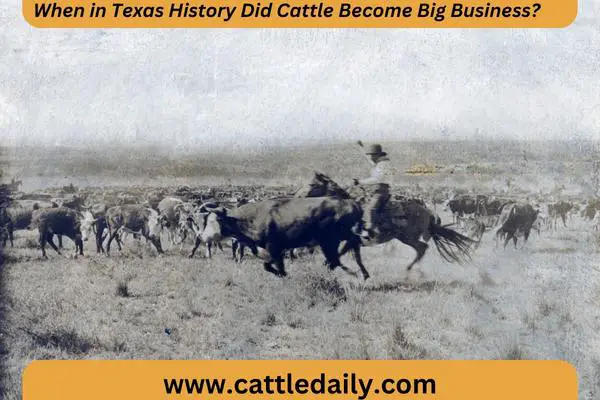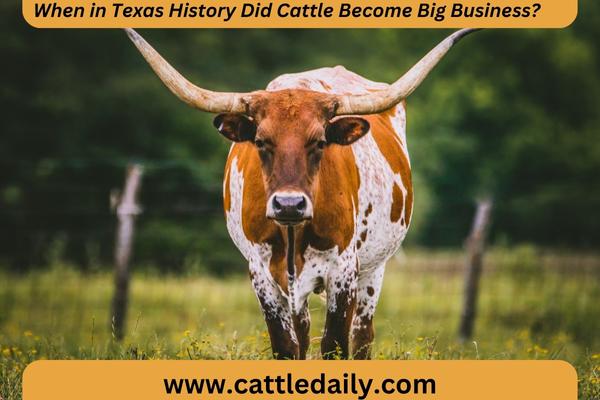The cattle industry has played a pivotal role in the history and economy of Texas. But when exactly did raising cattle transform from a means of basic sustenance to a major commercial enterprise in the Lone Star State?
The Humble Beginnings of Cattle Ranching in Texas
Cattle and ranching first came to Texas in the 1500s with the arrival of Spanish colonists and missionaries. However, in these early days, cattle served largely to provide meat, milk, hides, and tallow for domestic consumption rather than international trade.
Through the 1700s, free-roaming cattle multiplied rapidly across South and East Texas as Spanish ranches expanded. But it wasn’t until after 1800 when Americans began settling in Texas that cattle ranching started its ascent towards becoming big business.
The Great Western Cattle Trail Blazes a Commercial Path
In the decade between 1866 and 1886, cattle ranching in Texas was completely transformed by the advent of long-distance cattle drives.
The Great Western Cattle Trail established a route for Texan cowboys to herd cattle northwards across hundreds of miles to railway shipping points in Kansas. From there, cattle were transported by rail to meet the booming demand for beef in eastern and northern cities.
Within two decades, over 5 million cattle made the trek up the Great Western Trail. Fueled by this new access to markets, the Texas cattle industry grew more valuable.
By 1886, it was worth over $200 million. Ranchers expanded their herds and landholdings enormously during this trail-driving boom.

Barbed Wire Fences Change the Cattle Business Forever
Right when the great cattle drives reached their peak in the mid-1880s, revolutionary barbed wire fencing became widespread across West Texas.
This enabled ranchers to confine, protect, and manage their swelling herds year-round instead of relying on cattle drives each season.
Within just five years, most of the open-range land in western Texas was fenced off with barbed wire. This marked the end of epic cattle drives but also the beginning of dramatic improvements in herd genetics and beef quality to match market demand.
Scientific cattle breeding was now possible, catalyzing the maturation of Texas ranching into a sophisticated, commercial powerhouse industry by 1890.
The 1897 Trail Drivers Reunion Celebrates the Trail Driving Era
In September 1897, a three-day event was held called the “Trail Drivers Reunion” to reminisce over the bygone glory days of the cattle trails. Over a hundred veteran cowboys attended as guests of honor alongside thousands of spectators.
This event cemented the trail driving period’s legendary status as the time when cattle ranching transitioned to big business in Texas.
The Oil Boom Brings New Ranching Innovation
Spindletop blew in 1901 ushering in Texas’ great oil boom era. The petroleum and technology breakthroughs fueled widespread tractor and truck usage on ranches instead of horses by the 1920s.
Advances in nutrition science also drove innovations in supplementary cattle feeding and confinement systems during harsh winter months.
Ranchers began improving their herds even further by keeping detailed productivity records and using artificial insemination from elite bulls.
These scientific ranching innovations caused Texas beef output to double between 1940 and 1960 even as the total number of cattle declined.
The Rise of Meatpacking Giants
By the 1960s, the cattle industry faced a new threat – the rising market power of national meatpacking companies like Iowa Beef Processors (IBP). Meatpackers aimed to lower meat prices by utilizing boxed beef and bypassing traditional livestock auctions at local markets.
In response, Texas cattle ranchers worked to counterbalance the consolidated meatpackers by establishing certified Angus beef programs and integrated relationships with dedicated processing plants.
Despite challenging periods of consolidation and globalization since 1960, Texas ranchers have maintained economic independence while evolving into sophisticated agribusiness operators today.
Key Takeaways: Cattle and Big Business in Texas
- Origins of cattle ranching date back to 1500s Texas but large-scale commercialization happened after the Civil War
- The Great Western Cattle Trail (1866-1886) opened the path to driving millions of cattle northwards to national markets
- The advent of barbed wire fencing in the 1880s enabled cattle breeding improvements and maturation of the industry
- The 1897 Trail Drivers Reunion celebrated the pivotal era when cattle ranching became big business
So in essence, the two-decade period between 1866-1886 marked the pivotal transformation of the Texas cattle industry from local supply to a booming commercial enterprise integrated with national demand and transportation infrastructure. This was the genesis of cattle becoming big business in Texas.


